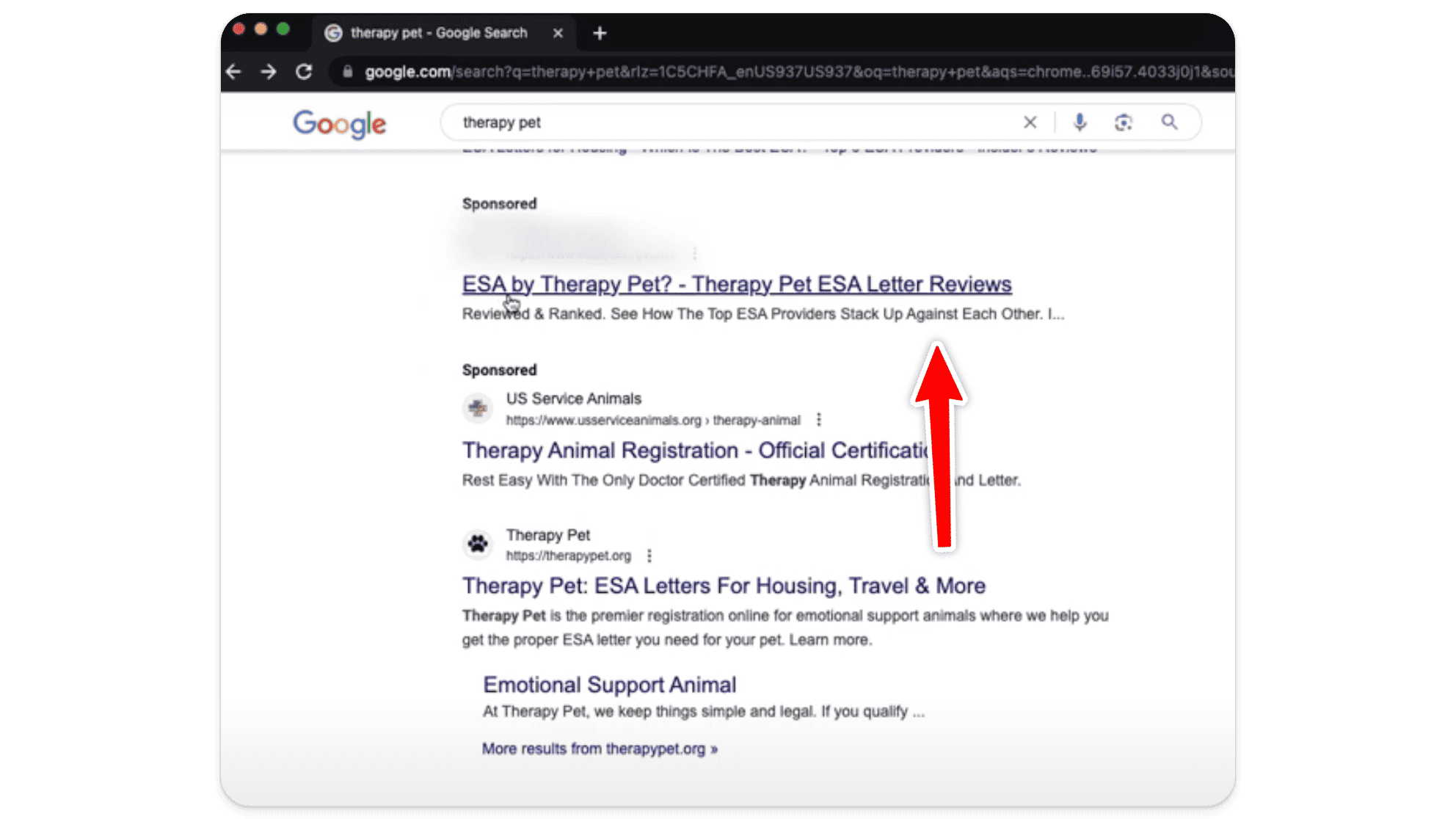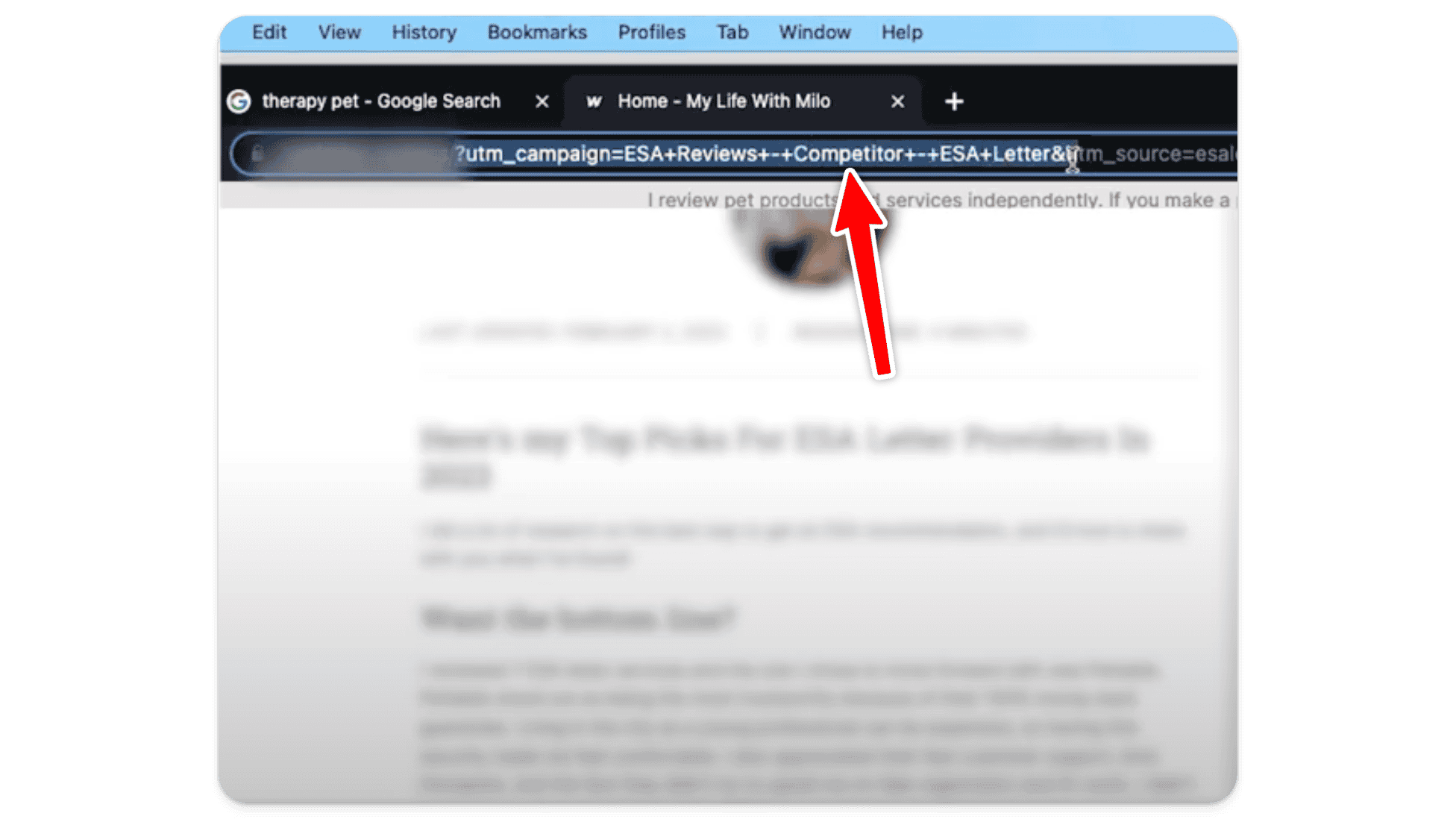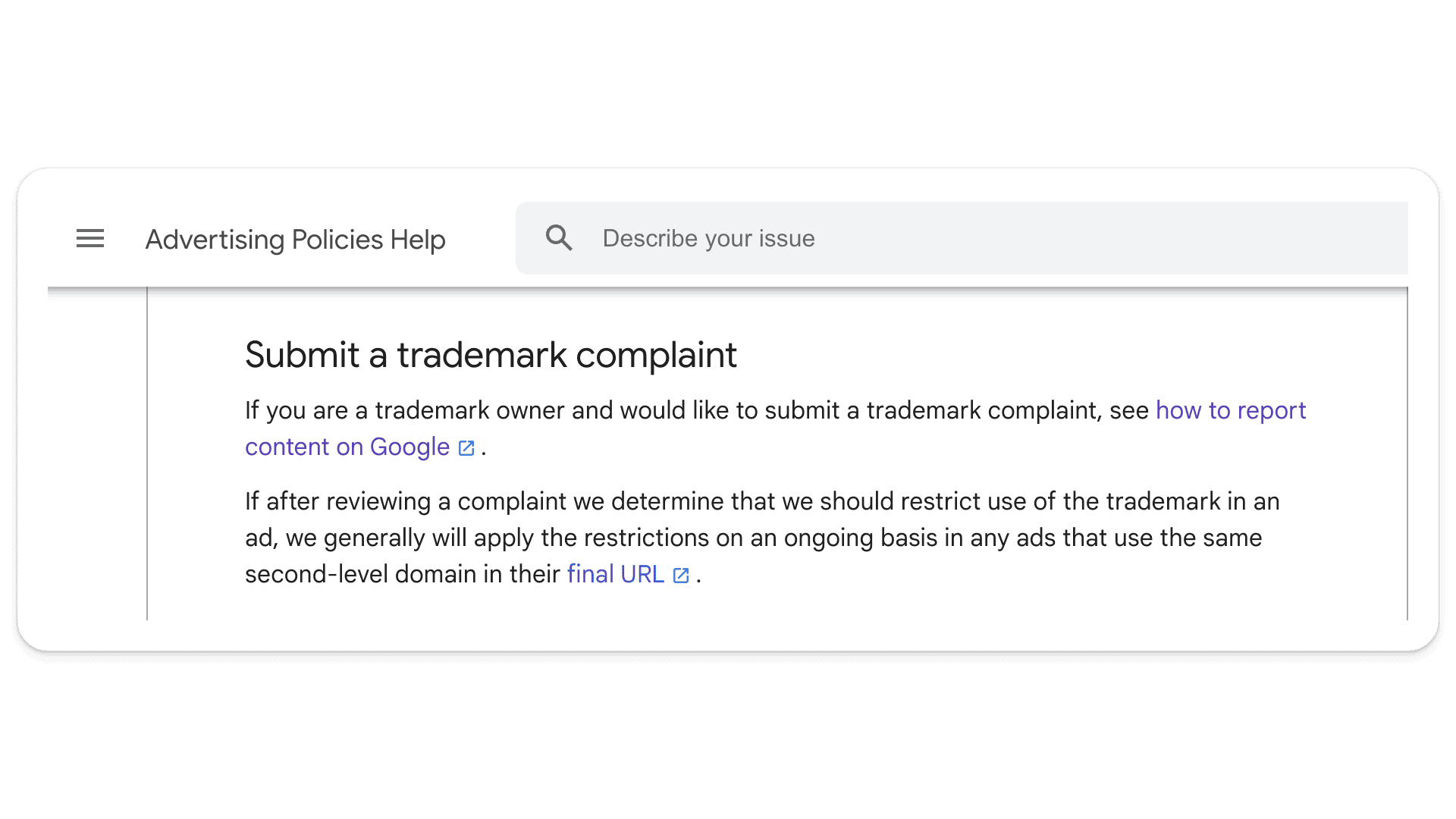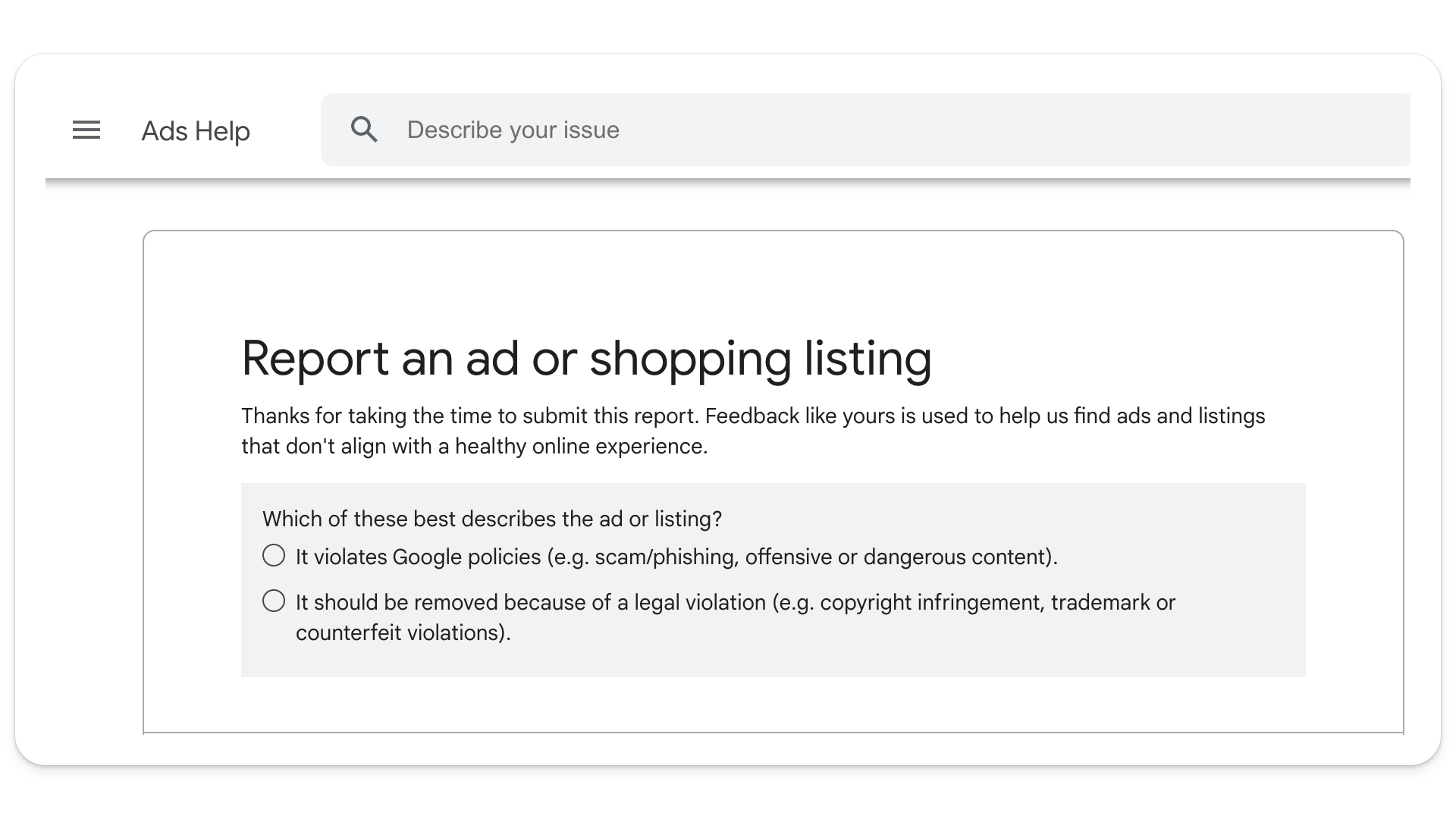Google Ads is easily one of the best platforms out there for getting in front of high-intent traffic…and nothing (arguably) is more high-intent than a branded search. Getting someone to buy from you who’s already googling your name?! This should be easy, right? Not if one of your competitors is using your brand name in their ad an attempt to siphon traffic from your business to theirs.
If you’ve found yourself in this frustrating situation, you’re not alone. It happens more often than you’d think, and while it might seem daunting, there are steps you can take to address it. Soon, you’ll be saying:

Let’s dive in:
Understanding the Problem
To illustrate this problem, we’re using a real-world case study. We have nothing to do with either brand, but it’s a great example of how type of thing can work.
So, Therapy Pet is a company that helps people register their emotional support animals. But, if we google “Therapy Pet,” they are not the first to pop up. Instead, we find an ad that begins, “ESA by Therapy Pet?”

When we click the ad, it takes us to a page. Based on the URL, it’s pretty clear what’s going on here:

Someone (a competitor) is deliberately using your brand name to attract your potential customers on Google Ads. So, what can you do about it?
Step 1: Contact the Advertiser Directly
The first and often most effective step is to contact the advertiser directly. Here’s how:
Find Their Contact Information: Look up their website, find their contact email, or even connect with them on LinkedIn.
Send a Friendly Message: Approach them in a non-confrontational manner. Don’t threaten. Don’t accuse. Here’s a template you might use (and include a screenshot of the ad):
“Hi [Advertiser’s Name],I represent [Your Brand Name], and we see that you have our name deliberately in your ad. We understand that this could be due to a dynamic search ad campaign or maybe an agency is running your ads and you didn’t know about it. We would like you to please take this down, and any other ads that you may have with our brand name in it.
Best,
[Your Name]”
Most of the time, people will respond positively to that, and take the ad down.
Why This Approach Works
Approaching the advertiser directly, using a friendly and understanding tone often yields positive results because:
Human Connection: Direct communication humanizes the interaction. When you approach someone with respect and understanding, they are more likely to respond in kind.
Awareness: Sometimes, the advertiser might not be aware that their ad is infringing on your brand name, especially if they are using automated ad placements (or if they’ve hired an agency).
Goodwill: By not immediately resorting to threats or legal action, you foster goodwill and increase the likelihood of a cooperative resolution.
Step 2: Submit a Trademark Complaint to Google
If direct contact doesn’t work or you don’t get a response, the next step is to submit a trademark complaint to Google.

This only works if you have a registered trademark for your brand name.
The Google Ads trademark policy is fairly strict, and Google will try to process trademark complaints as quickly as possible.
Here’s how to alert Google to a possible trademark infringement:
Visit the Google Support Page: Go to the Google Trademark Complaint Form.
Fill Out the Form: Provide all the necessary details, including proof of your trademark and evidence of the trademark infringement.

Google takes trademark complaints seriously and will investigate and take action if the claim is valid.
Tips for a Successful Trademark Complaint
Documentation: Ensure you have all the necessary documentation ready, including proof that you are the trademark owner and evidence of the infringing ad.
Detail: Be detailed in your complaint. Explain clearly how the ad infringes on your trademark and the impact it has on your brand.
Follow-Up: After submitting the complaint, follow up with Google if you do not hear back within a reasonable amount of time. Be persistent. As the trademark owner, you have the right to protect it on the Google Ads platform.
Step 3: Report the Ad to Google
If you are not a trademark owner, you can still report the ad to Google, though this process can be slower and the outcome is less certain. Here’s how it works:
Complete the Report an Ad Form: Fill out the form with all relevant information about the offending ad.

Submit and Wait: Unfortunately, this process can take some time, and Google’s response might not always be in your favor. However, it’s always worth a shot.
What to Include in Your Report
Screenshots: Take clear screenshots of the infringing content and any relevant Google search results.
Details: Provide a detailed description of how the ad is infringing on your brand and why it is problematic.
Impact: Explain the negative impact the ad is having on your business, such as loss of customers or brand confusion.
It’s important to touch on each of these three elements, as the more detail your provide Google (and the clearer you are about the harm being done to your business and/or reputation, the better).
Step 4: Hire a Lawyer
If all else fails, and the offending ads from a direct competitor continue to harm your brand, the last resort is to hire a lawyer.
Legal systems worldwide may differ, but usually a lawyer can send a cease-and-desist letter to the advertiser. In most cases, receiving a legal letter prompts immediate action.

Note: In over a decade of experience, we’ve rarely seen it come to this. Usually, contacting the advertiser directly solves the issue.
It’s often better to give people the benefit of the doubt first before resorting to legal action.
Choosing the Right Lawyer
Specialization: Look for a lawyer who specializes in intellectual property and trademark law. Their expertise will be crucial in handling your case effectively and efficiently.
Reputation: Check the lawyer’s reputation and past cases to ensure they have a track record of success in similar matters.
Cost: Understand the costs involved. Legal action can be expensive, so it’s important to weigh the potential benefits against the costs.
Proactive Measures to Protect Your Brand
While the steps above are reactive, it’s also important to take proactive measures to protect your brand from future infringements on Google Ads. To make life easier, you might consider:
Registering Your Trademark
If you haven’t already, registering your trademark is key to ensure your brand name remains protected (on Google Ads, and beyond). Here’s why:
Legal Protection: A registered trademark gives you the legal backing to protect your brand name and take action against any trademark infringement. In this instance, you would simply need to submit a trademark complaint to Google, which is much simpler than hiring a lawyer.
Deterrence: Knowing that your brand name is trademarked can deter competitors from using it in their ads.
Value: A registered trademark can add value to your brand and provide a sense of security.
Monitoring Your Brand
Regularly monitoring your brand’s online presence can help you catch any infringements early. Here’s how to go about it:
Google Alerts: Set up Google Alerts for your brand name. This way, you’ll be notified whenever your brand name appears online.
Ad Monitoring Tools: Use tools that can monitor online ads for any use of your brand name. These tools can provide real-time alerts and detailed reports.
Manual Checks: Periodically conduct manual checks of search results and Google Ads to ensure your brand name is not being misused. You can do this by googling your brand name.
Case Study: Successful Brand Protection
Let’s look at a real-world example to illustrate how these steps might be successfully implemented.
The company in this example is fictitious.
The Scenario
A mid-sized ecommerce company, let’s call them “EcoGoods XYZ,” discovered that a competitor was using their brand name in Google Ads.

The competitor’s ad read, “EcoGoods XYZ Alternatives – Better Prices.”
The Action Plan
Direct Contact: EcoGoods XYZ’s marketing team visited the competitor’s website and found the their contact information. Then, they sent a friendly email requesting the removal of the brand name from their ads.
Trademark Complaint: As they were not the trademark owner, EcoGoods XYZ could not submit a trademark complaint to Google (as there was no trademark infringement).
Reporting the Ad: However, they were able to report the ad through Google’s Report an Ad form, including detailed descriptions of the competitor’s ad and screenshots.
Legal Consultation: As a precaution, EcoGoods XYZ consulted with their legal team to prepare for potential further action.
The Outcome
Within two weeks, Google had removed the infringing ad, and the competitor apologized, explaining it was an error made by their advertising agency. EcoGoods XYZ’s proactive and professional approach ensured a swift resolution (with no need for legal action).
Better still, their brand name is protected.
Final Thoughts
Dealing with competitors using your brand name in their ads can be frustrating, but it can also be resolved fairly easily, provided you stay calm and follow the steps outlined above.
Most of the time, a friendly request will resolve the issue.
If not, Google’s trademark complaint (if you are the trademark owner) and/or Ad Infringement processes are your next best options. Only resort to legal action as a last resort, when all else fails.
Remember, clear communication and a professional, friendly approach are key.
…And if this isn’t a problem you’re (currently) dealing with on Google Ads or elsewhere, you might consider taking proactive measures, such as registering your trademark and monitoring your brand’s online presence, to prevent future issues with trademark infringement.
By following these steps and staying vigilant, you can protect your brand and maintain your competitive edge in the market.
Prefer to watch a video?



